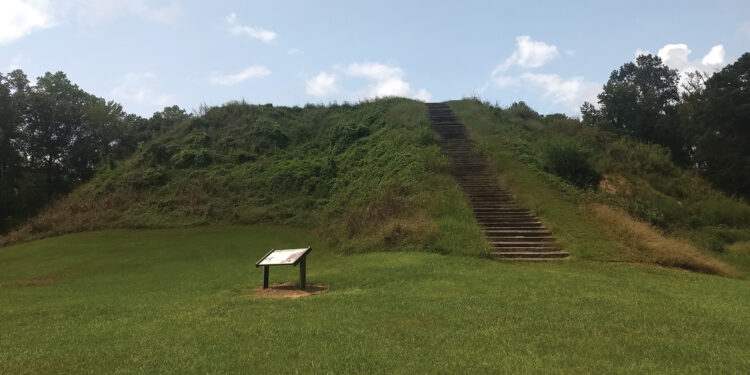By Morgan Taylor, Reporter
MOUNDVILLE, Alabama – Legislation has recently passed in the Muscogee (Creek) Nation National Council that called for the restoration and protection of the historical mounds of Moundville located near the Black Warrior River in AL.
The University of Alabama owns the historical site Moundville that has cultural ties to Native American heritage, particularly those Muskogean speaking tribes and not limited to the MCN.
MCN Historical and Cultural Preservation Department Archaeological Technician Turner Hunt and MCN Historical and Cultural Preservation Department Tribal Archaeologist LeeAnne Wendt have been an active part of the ongoing project.
According to Hunt, archaeologist who have studied Moundville have traced the Muskogean people starting in the year 1450.
“Unfortunately, erosion has taken a toll across this very important historical site,” Wendt said. “One cause of this erosion is due to the farming practices of the 19th and 20th centuries. The soil at Moundville is great for agricultural use and drainage but due to the lack of clay content of the soils causes it to be unstable there. If you think about it farming in the area for over 100 years can cause those soils to erode even more heavily.”
In 1938, the Civilian Conservation Corps (CCC) began an erosion control program at Moundville.
“As you can see, we are still dealing with this erosion even though there’s not any farming practices the erosion is still going on, so this is only one cause and there is another cause too.” Wendt said.
The Black Warrior River has a natural horseshoe bend where Moundville is located on the river.
“On any kind of river where you have a horseshoe bend, you’ll have an erosion side and a deposit side,” Hunt explains. “It happens to be that Moundville is on the erosion side of the river. So, as it naturally flows through it will erode the riverbank.”
“There is an argument to be made that kind of changes things,” Hunt said. “We have seen Hurricane Laura pass through massive amounts of rain through the area and that rain has to go somewhere, it runs off the river dwell and makes the situation worse.”
As erosion has occurred, human remains, and artifacts have been discovered over the 300-acre area.
“In its later life, Moundville was a cemetery,” Hunt said. “People would return from all over and use it as a cemetery so its multiple levels of cultural significance for us.”
“This is why we are so invested in the project and why they have to be careful doing this work,” Wendt said. “They have found human remains, cultural artifacts across that site, thousands of burials have been found out there. There is always the probability they will find human remains or artifacts.”
TR 20-159 allows the Principal Chief to execute a Memorandum of Agreement (MOA) between the U.S. Army Corps of Engineers, Mobile District, the Alabama State Historic Preservation Officer, and the Advisory Council on Historic Preservation regarding the Emergency Streambank and Shoreline Protection Project Tuscaloosa, AL.
“A MOA Is a legally binding document between state, federal and tribal partners,” Hunt said. “In this case a MOA is necessary for work to begin because there is an adverse impact of the project. This will ensure that all stipulations set forth are followed.”
The U.S. Army Corps of Engineers is the lead federal entity on the project. The MCN has requested weekly reports, as stated in the legislation. The legislation was passed in the National Council meeting on Sept 26. Mvskoke Media plans to report on the project as it proceeds.






The lock and dam system are the reason the banks of Moundville are eroding. The river is way wider than it was back then.
The lock and dam system is the reason the banks of Moundville are eroding.